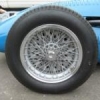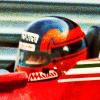Heroic Age drivers - Théry and Velghe
#1

Posted 22 February 2002 - 14:38
In the March 13, 1909, issue of 'La France Automobile' the death is announced of Leon Thery - the great Richard-Brasier driver who won back-to-back Gordon Bennett Trophy races in 1904 and 1905, the first on the Taunus course based near Saalburg in Germany and the second on the Auvergne circuit around Rochefort in France. He seems to have been an Alain Prost of his day - peerlessly competent, reliable and yet truly fast - 'The Chronometer' was one of the nicknames the press gave him.
The obit explains that he came to prominence in the Tour de France of 1899 which they had sponsored, 2nd in a Decauville voiturette. In public estimation if there had been a superstar racing driver of 1904-1905, Thery would have been it - he had died 'after a long and sad illness' - which sounds like cancer or, at that time, TB. The obituarist described him as having been 'one of the finest champions of the motor sporting world' - which he truly was.
Searching further I also came across the obit for Alfred Velghe. in the March 5, 1904, issue. No reaction? Pehaps if I said he raced under the pseudonym 'A. Levegh' - as would his descendant 'Levegh', driver of the fatal Mercedes-Benz 300SLR at Le Mans '55.
The obit relates how 'Levegh, one of the most brilliant racing drivers, passed away last Sunday at Pau, in his villa Bagatelle, in which forseveral years he had spent each winter. He had retired rom racing in 1900, since when he had sufered from chest trouble which was ameliorated by the mild climate of the Midi'.
Velghe had been a cycle racing star at the Stade Buffalo and Velodrome of the Seine, and in 1899 had begun driving Mors cars in all the great races.He had won the Paris-Ostend and Bordeaux-Biarritz races (it says) and then in 1900 he had been elevated incontestably to racing Champion status by victories in the Paris-Toulouse, Bordeaux-Perigueux and in the sprints of the Speed Week at Nice.
"Alfred Velghe, better known under his pseudonym 'Levegh', was a sportsman in every meaning of the term. He possessed to a great degree the qualities of sang-froid and prudence and was known as one of the most reliable of drivers. His funeral was held at La Trinite."
'Levegh' (1) was evidently very highly regarded within the motor sporting fraternity at that time, 1904, and 50 years later it was his nephew???? grandson???? I can't recall which but I'm sure I will be told - who smashed into the tail of Lance Macklin's Healey at Le Mans, and was launched towards the safety bank and the spectators beyond. Reading the original 'Levegh's obit like this enables one to appreciate more the burden of expectation that the introspective, driven, 1955 model felt he carried upon his shoulders...
Who else rates early racing - and racing cars - and events - best driver? best car? Or will there be only 2 or 3 of us??? I'm just curious to know.
DCN
Advertisement
#2

Posted 22 February 2002 - 14:44
#3

Posted 22 February 2002 - 14:53
The Bruce-Brown birthdate pursuit stemmed from a request in another place to learn the age of the youngest-ever Grand Epreuve winner or somesuch.
Use of the search facility will always reveal things for you... 'Search BB' just below the banner on the top right hand side of the page...
#4

Posted 22 February 2002 - 14:57
#5

Posted 22 February 2002 - 15:49
#6

Posted 22 February 2002 - 16:05
As said Richard, yes indeed Doug ! Théry was really a hero in France thanks to his two Gordon-Bennett Cup (err International Cup ;) ) wins. He was 30 years old only when he died which means he could still have done great things in the sport (even if the years following his passing were quite a black hole for international racing).Is TNF interested at all in pre-WW1 racing topics?
I have that he died of "hydropisie chronique" which I wouldn't know how to translate in English or even explain (well I'll try : it is when some water gets stuck in inapropriate parts of your body, most often in the lungs IIRC) but maybe Richard or kpy will come to the rescue on this !he had died 'after a long and sad illness' - which sounds like cancer
Thanks for interesting Levegh obituary. Just one minor correction : I think he retired in 1901 (he led the Gordon-Bennett Cup that year before retiring).
As for my favorites drivers of the era, there were so many greats... I have a little fondness for men like Louis Wagner, Felice Nazzaro or Victor Hémery who had a long and successful career.
#7

Posted 22 February 2002 - 16:26
Pneumonia?Originally posted by FEV
I have that he died of "hydropisie chronique" which I wouldn't know how to translate in English or even explain (well I'll try : it is when some water gets stuck in inapropriate parts of your body, most often in the lungs IIRC) but maybe Richard or kpy will come to the rescue on this !
#8

Posted 22 February 2002 - 17:48
Ugh - poor devil. This sounds surely like Dropsy, to which numerous deaths were attributed at that period. Its not really a distinct disease as such - its an accumulation of fluid under the skin or in body cavities associated with circulatory problems or 'water in the blood' which is as nasty as water in the oil. Tumours, cirrhosis and kidney disease can all produce the effect. Thery was said to have suffered long from the condition. He looks a roly-poly, puffy kinda chap - like us proper chaps should look - but maybe with him it was this developing condition. I have some super pix of him and if I can work out this electrickery I will umm 'post' them for you.
DCN
Edited by Doug Nye, 11 October 2021 - 19:02.
#9

Posted 22 February 2002 - 21:27
Can we clear up, once and for all, whether M Bouillon legally changed his name, or merely used it as a nom de course. I have always believed the former, in which case we should refer to him as Pierre Levegh - as most period reports do. Yet 97.8% of references these days are to "Pierre Levegh" (in quotation marks), which suggests a nom de course
Anyone?
#10

Posted 22 February 2002 - 22:24
#11

Posted 23 February 2002 - 02:07
#12

Posted 23 February 2002 - 03:06
* April 16, 1879 in Paris
† March 8, 1909 in Paris on tuberculosis, consumption or dropsy
Léon Théry, born on April 16, 1879, was the most famous French driver up to 1909 and during the pioneer years. He appeared at the racing scene in 1899 at the 565 km long Paris-Bordeaux race where he retired his Decauville Voiturette. But two months later at the Tour de France he came second, driving again his Decauville. In 1900 he won the Coupe des Voiturettes at the Paris-Rouen-Paris race. Later that year at the Nice-Marseille race he placed his Decauville third. In 1901 the 3-liter, 16-hp Decauville advanced to the light car class, and Théry entered for the Paris-Bordeaux event where he came fifth. The following year he was part of the Paris-Vienna event where he drove a 2-cylinder, 18-hp Decauville in the light car class but ran into trouble and finished at a lowly seventysecond place. Later in 1902 at the first Ardennes circuit race, he drove again in the light car class and crashed on the second of six laps. He was nicknamed ‘Mort aux Vaches’ by his colleagues as a result of this incident.
In 1903 Théry entered at the tragic Paris-Madrid race, driving a 30 hp Decauville light car, which he placed twentysixth when the race was stopped at Bordeaux. However, Théry lost time to help in the Renault accident. He was the next car to arrive at Marcel Renault’s tragic accident. Théry brought his Decauville to a stop, when he saw witnesses of the accident remove Renault and his mechanic Vauthier from the crumpled car. No doctor was at hand, but Théry found one at the next turn and sent him pedaling back to the spot on a bicycle. During 1904, Théry was given the nickname “the Chronometer’ for for his consistent driving, the regularity with which he completed each lap while driving for Richard-Brasier.
At the fifth Gordon Bennett Race in 1904, he won the French Eliminating Trials. His regular driving paid off in the race itself, which the then 25-year-old Léon Théry won with a 80-hp Richard-Brasier ahead of a German Mercedes, driven by the Belgian Camille Jenatzy. This meant that the race was going to be staged in France the following year. On the Wehrheim and Limburg downhill sections, Théry and Jenatzy exceeded the 180 kilometer speed. Over three kilometers per minute and that on a narrow tree-lined dirtroad. Théry was compared to Felice Nazzaro and like him he was a very competent mechanic. On lap three, Théry had lost about seven minutes when a wing of the coolingfan had broken off. Straight away he removed the other wings to prevent further fractures from the now out of balance fan. His confidence in his constant speed, which now provided the only cooling, did not deceive him. Théry drove every corner with contempt of death in order to make up time in a lap which took him 1h29m52s. Lap four, the last last lap was his fastest in 1h23m28m. He won by 11m28s. The calm phlegmatic Frenchman did not win by luck, he earned his victory.
By 1904 the Gordon-Bennett Cup had become the most important event of the year because the French Government did not allow the annual town-to-town races to take place any more, which had ended with the tragic 1903 Paris-Madrid event. The Gordon-Bennett rules limited each country to be represented by only three cars. This rule now caused great discontent within the French auto industry. France alone had seven manufacturers of whom any could have been a winner and wanted a race where each factory could be represented by three cars.
Then in 1905, the last of the six Gordon-Bennett Cup Races took place in France on a 137 km mountainous circuit in the Auvergne. This race must have been the most important event up to that time, when looking at the strong entry of three cars from each of the six participating nations. From America came two Pope-Toledos and one Locomobile. Austria entered three Mercedes cars, from France came one de Dietrich and two Brasiers. Germany entered three Mercedes and England appeared with one Napier and two Wolseleys and from Italy came three FIAT entries. The three Pipes from Belgium did not show up. The cars were painted again in different colors to identify the competing Nations: The Americans were red, the English cars were green, the French light blue, the Germans white, the Italians black and the Austrians black-yellow.
At the Eliminating trials on June 16 and the following Gordon Bennett Race on July 6, 1905, Théry repeated both wins from the year before with the exception that his Richard-Brasier had his engine increased now to 96 hp. From the 18 cars, which took part in this race, only 12 made it to the finish. The reason for this poor result was the extremely difficult circuit in the Auvergne with many feared and dangerous curves and a stony and hard road surface, which had a devastating effect on the tires and burdened drivers and cars alike. After 549 km and 7h02m42.6s at an average speed of 77.78 km/h, Léon Théry on a 96 hp Brasier won for the second year in a row. He was over ¼ hour ahead of the feared second placed Nazzaro on a 110 hp FIAT. The trophy stayed in France. Vive la France! Vive Léon Théry.
He retired from racing in 1906 to establish a Paris Taxi business but had been induced by Brasier to return to racing at the 1908 Grand Prix, where he drove a 120 hp Brasier. During the race Théry had been displaying his accustomed regularity and at one time moved his car into third place. He retired on the ninth of ten laps, after his Brasier failed him, when in fourth place. This was his last race. Only 30 years old, Léon Théry died much too young in Paris on March 8, 1909 of tuberculosis but other sources state that he died of consumption or even of dropsy.
© H. Etzrodt
#13

Posted 23 February 2002 - 11:21
One never finds Bouillon in French sources. In Blight, "The French Sportscar revolution" it is explained how Pierre started racing under his real name - Bouillin - and switched to the "nom de course" Pierre "Levegh" around 1938.
As for Thery, the following might add something to what Hans said:
Here are Théry’s “podium finishes”
Year Race Class Pos Car
1899 Critérium des Voiturettes 2 Decauville
Tour de France Automobile Voiturettes 2 Decauville
CC de Chanteloup Voiturettes 2 Decauville
1900 Coupe des Voiturettes 1 Decauville
Nice-Marseille Voiturettes 3 Decauville
Meeting Provençal (100 km) Voiturettes 1 Decauville
CC de La Turbie Voiturettes 1 Decauville
Critérium des Voiturettes 2 Decauville
Bordeaux-Périgueux-Bordeaux Voiturettes 1 Decauville
Semaine de Nice - Prix de la Société des Bains de Mer
Voiturettes 3 Decauville
1901 CC de La Turbie Voiturettes Tourismes 1 Decauville
CC de Gaillon 2 Decauville
Voitures Légères 1 Decauville
Semaine de Nice (Nice-Draguignan-Nice)
Voiturettes Tourisme 1 Decauville
Courses de Deauville - Mille arrété + KM. lancé
Voiturettes 3 Renault
1902 Course de Vienne - Mille lancé 3 Decauville
Meeting de Dourdan - Km lancé Voitures Légères 1 Decauville
Courses de Deauville - Km lancé Voitures Légères 1 Decauville
CC de Gaillon Voitures Légères 1 Decauville
1904 Eliminatoires de la Coupe Gordon-Bennet 1 Richard-Brasier
Coupe Gordon-Bennett 1 Richard-Brasier
1905 Elirninatoires de la Coupe Gordon-Bennett 1 Richard-Brasier
Coupe Gordon-Bennett 1 Richard-Brasier
While preceding Gordon Bennet winners Edge and Jenatzy were men and drivers very much belonging to their Edwardian era, Frenchman Léon Théry (b. 1879) was exquisitely modern. To my knowledge Thèry was the first in a long line of drivers, among them some of the greatest ever, who had the gift of being consistently fast , but not faster than needed to win (such for instance Nazzaro, Varzi, Fangio, Stewart, Lauda, Prost). Théry used to study the circuit thoroughly, methodically recognizing its lesser particulars, then establishing a race log that would take into account the difficulties of the track, the quality of the tyres with respect to them, and the solidity of his car (which he knew perfectly, since he was an excellent mechanic and tuner). He would then follow scrupolously the speed he had calculated in his famous race log. His name will be forever linked with Gordon Bennett’s for his two victories in the 1904 and 1905 Trophies and the corresponding two victories in the French Eliminating Trials that were true GPs in their own right. It is amazing to read how famous Théry suddendly became after his 1904 Taunus win. Back from Germany with Henri Brasier, they received an enthusistic reception in the ACF premises. They appeared on the balcony and thousands of Parisian cheered at them. A series of banquets and other festivities would follow, where - during one of them - Fernand Charron announced that the subscription that he and other friends had started had raised 12,200 FF. He was given also the interests of a lifetime bond. Another subscription was opened for the three mechanics that had accompanied him, among them the faithful Muller, Théry’s shadow and riding mechanic.
Brasier presented Théry with the winning car that he took to America, earning a big purse, but little racing success. After the two 1905 victories, his fame was such that Théry tried to bank on it, starting his own car factory and abandoning competition. It was a dismal failure and we find Théry as chauffeur for the La Vie au Grand Air reporter at the Bordeaux-Paris bycicle race in May 1908. He had to resume racing for Brasier at Dieppe in the 1908 GP. He was running fourth and first of the French cars, when a broken wheel obliged him to retire during the last lap. Théry was already suffering of a severe kidney ailment that was going to kill him on March 8th, 1909. Knowing that, it is sad to look at Théry’s photographs: he is much round, looking more inflated than fat; Henri Brasier called him “Pauvre Gros” (“Poor Fatty”). Théry was good-natured and simple. Some describe him as somewhat lazy. He certainly was flegmatic and meticuluous; his racing tactics, among the flamboyant drivers of the period, gave the impression of him going slow, of being too prudent, but his calm, his stamina, his cool blood, his assurance and his clever sense of the race always paid off. Before going to posterity as the Gordon Bennett Champion, Théry had been the Voiturettes Champion. He was faithful to the Decauville make since his beginnings in 1899 to the Paris-Madrid 1903. His first race, the 1899 Paris-Bordeaux, was nonetheless unauspicious: at the tiller of a Decauville, which maximum speed did not exceed 30kmh. he arrived at Bordeaux, after 565 kms, totally exhausted and struck by amnesia and was heard repeating: “Do not stop me, I have to arrive at Bordeaux!”. Another bad moments in his career took place in 1902: a brake failure in the Arlberg downhill (!) during the Paris-Vienna, when his skills and cool blood saved both him and Muller and he was able to resume racing, and the hit of a cow at full speed during the Ardennes race.
#14

Posted 23 February 2002 - 11:32
It was of course after his collision with the cow that some in the French press nicknamed Thery 'Mort aux Vache' - 'Death to Cows' - which I presume trips off the tongue far more readily in French than its translation does in English.
Like Raymond Sommer apparently being dubbed 'The Wild Boar of the Ardennes' for some reason or 'Coeur de Lion' - Lionheart..
I can appreciate Lionheart - that was plainly true - but as for the other tag...
These celebrated media nicknames always struck me as being exquisitely stupid - step up to the hotel bar with Sommer and say to him "Well, Wild Boar of the Ardennes, me old mate, what'll you have?"....I don' think this would have happened, do you?
DCN
#15

Posted 23 February 2002 - 12:44
After his rise to stardom - Land Speed Records, Gordon Bennett win etc etc - Jenatzy's career went into a long decline, pedalling a Mercedes 120 GP car in sprints, to no great effect. He subsequently retired to his estate in Belgium, where he inadvertently fulfilled his own prophecy that he would die in a Mercedes - it was not the way he expected though! Out shooting one day, the red-bearded Jenatzy (known as the Red Devil) was mistaken for a wild boar (!!) and fatally injured by another 'marksman' - he expired in the back of a Mercedes which was rushing him to medical help. This must be one of the most bizarre ends for any racing driver.
#16

Posted 23 February 2002 - 13:37
#17

Posted 23 February 2002 - 13:53
#18

Posted 23 February 2002 - 23:16
DCN
#19

Posted 23 February 2002 - 23:17
Advertisement
#20

Posted 23 February 2002 - 23:27
Just hit the IMG button and then paste in one of the URLs I gave you. For example, I'll just try it here with "http://www.btinterne...lerBrasier.jpg" to make sure it's not something I've screwed up:

OK - I can see that. Can everyone else?
Allen
#21

Posted 23 February 2002 - 23:36
#22

Posted 23 February 2002 - 23:49
Look - I'll just go and stand in the corner, right? Could you post these things for me? I hit the IMG button paste the httplmenjpeg/%^£$"£""**& line and all I can see is a line of text... If I could run a plug check to see which cylinder isn't firing I'd be all right...but I know it doesn't work like that these days. Apologies for being such a poor pupil.
DCN
#23

Posted 23 February 2002 - 23:55
#24

Posted 24 February 2002 - 09:14
Vitesse is right. You will only see a line of text until you hit the Preview Reply or Submit button. Sorry, I should have explained that.
All your images are below:

1904 Gordon Bennett - Jenatzy

1904 Gordon Bennett - Thery Brasier 1st

1904 Gordon Bennett - Thery Muller Brasier

1904 Gordon Bennett - Thery right with Michelin de Zuylen de Knyff

1905 Ardennes - Jenatzy Mercedes

1905 Gordon Bennett - Thery Brasier Rochefort

1905 Gordon Bennett French Trials - Thery Muller Brasier
These are amazing images. To me, 1960 is early so to see images like this from the dawn of motor racing is incredible. For the first time I can remember, even my dear wife has expressed an interest and uttered the words "I'd like to see those pictures".
Allen
#25

Posted 24 February 2002 - 12:39
Especially the first one of Jenatzy.
#26

Posted 24 February 2002 - 14:49
Originally posted by Vitesse2
There's a few of us around Doug! One of my earliest racing heroes was SF Edge ...And we have spent a lot of time in a fruitless search for David Bruce-Brown's birthdate! And that's just for starters. Gotta go, work calls ...

Hello Vitesse. I also love the older era's (especially the '30s) and I'm also very interested in teh life of David Bruce-Brown. did U find his birthday ? And in which thread was it discussed ?
#27

Posted 24 February 2002 - 15:02
Originally posted by William Hunt
Hello Vitesse. I also love the older era's (especially the '30s) and I'm also very interested in teh life of David Bruce-Brown. did U find his birthday ? And in which thread was it discussed ?
William:
Start from here and follow the links!
http://www.atlasf1.c...ight=BruceBrown
#28

Posted 16 January 2009 - 16:58
#29

Posted 12 August 2014 - 15:41
Just for the heck of it, check out this pen & ink of Mr. Thery from my Website...
http://www.firstsupe...lery/leon-thery
#30

Posted 14 August 2014 - 10:32
Dear Mr Nye
I think these MEN must have been made of steel to endure the racing conditions (roads) and equipment (huge cars) etc. They must have been very strong men.
I truly admire these pioneers.
My mind has gone blank but was there not another pioneer driver called the 'chronometer' - an Italian who I think drove FIATS?
Regards
Rob
#31

Posted 14 August 2014 - 11:41
Thery was Le Chronometre. There are some accents in there that I cannot work out how to type. Presumably the Italian is Felice Nazzaro, who followed in the footsteps of other heroic era drivers like Charron and Girardot by founding his own marque.
#32

Posted 14 August 2014 - 12:00
That's it Felice Nazzaro.
How I enjoyed those Shell films narrated by Mr Mason on the Heroic days.
#33

Posted 14 August 2014 - 12:08
Thery was Le Chronometre. There are some accents in there that I cannot work out how to type.
'alt E' on a mäc ![]()
#34

Posted 14 August 2014 - 13:37
Doesn't the Mac have a 'Character Map' like Windows does?
#35

Posted 16 January 2020 - 18:51
Photo taken during the 1899 Tour de France "pour automobiles" (Jules Beau collection/Bibliothèque Nationale, Paris):
#36

Posted 18 January 2020 - 21:59
Apologies for my ignorance, but would the Clément be Adolphe who founded the car make, rather than his son Albert who was so quick but lost his life in (I think) 1907?
#37

Posted 18 January 2020 - 22:35
#38

Posted 19 January 2020 - 09:12
The eight men shown in the photograph from July 1899 are:
Arthur Pinson (46 years old, born 05 April 1853)
„Levegh“ (29, b. 16 June 1870)
Gaston de Chasseloup-Laubat (33, b. 07 June 1866)
George Heath (c.23 if born in 1876, or c.37 if born in 1862)
Léonce Girardot (35, b. 30 April 1864)
René de Knyff (33, b. 10 December 1865)
Adolphe Clément (43, b. 22 September 1855)
Emmanuel Boileau de Castelnau (42, b. 01 July 1857)
Edited by ReWind, 19 January 2020 - 09:13.
#39

Posted 19 January 2020 - 09:28
Confirmation:
Clément = Clément père = Adolphe Clément. He drove a four-litre Panhard in this 1899 Tour de France.
(photos Jules Beau collection)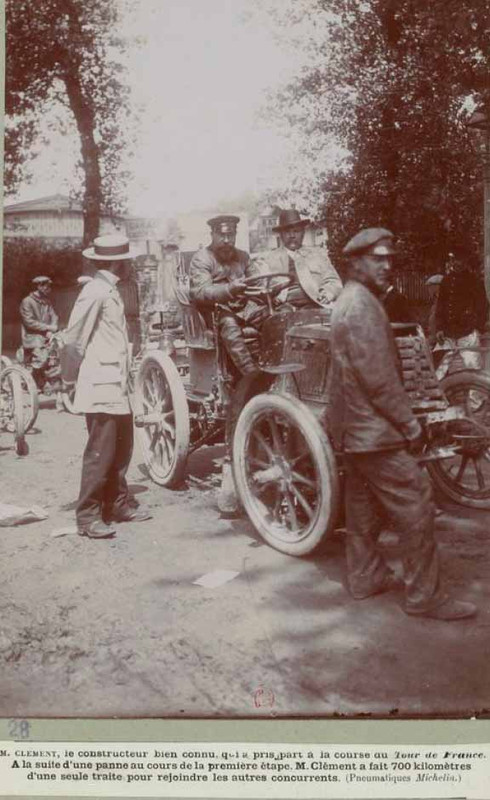
= = = =
The tricycle gang during the 1899 Tour de France: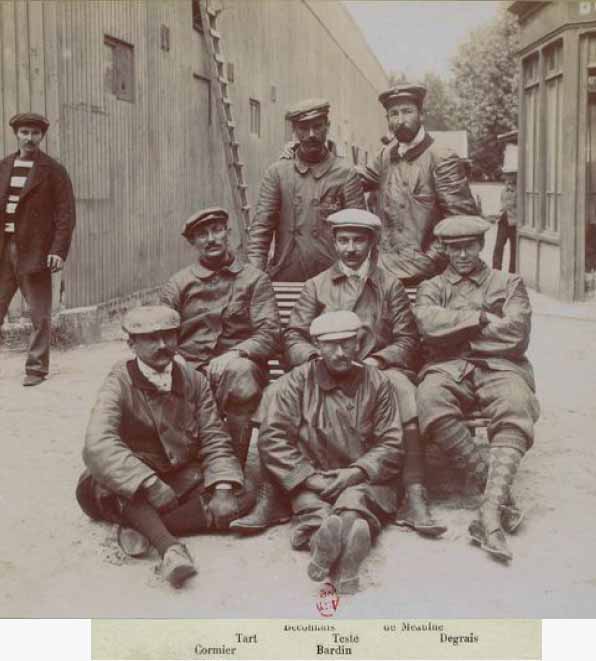
= = = =
Another well-known Panhard driver of 1899:
Georges Leys, his wife as mécanicienne and their four-litre Panhard finished second in the "Rallie-Papiers de la Vie au Grand Air dans la forêt de Fontainebleau", Sunday, 4 June 1899. The name of Madame Leys' couturier was not mentioned.
(A few days before, on 24 May, Leys had finished seventh in the race from Paris to Bordeaux; and in May 1898, he had won the race between Périgueux and Bergerac.)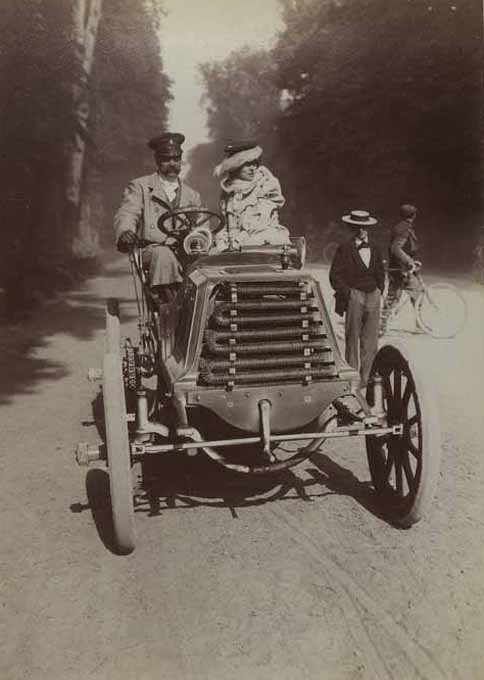
Advertisement
#40

Posted 19 January 2020 - 12:51
Pretty incredible stuff here...
I wonder if Doug could re-post his pics from nearly two decades ago?
#41

Posted 20 January 2020 - 07:48
= = = =
Another well-known Panhard driver of 1899:
Georges Leys, his wife as mécanicienne and their four-litre Panhard finished second in the "Rallie-Papiers de la Vie au Grand Air dans la forêt de Fontainebleau", Sunday, 4 June 1899. The name of Madame Leys' couturier was not mentioned.
(A few days before, on 24 May, Leys had finished seventh in the race from Paris to Bordeaux; and in May 1898, he had won the race between Périgueux and Bergerac.)
Now that is what I call style!
#42

Posted 20 January 2020 - 19:05
Levegh, mechanic Toussaint and their 4,2-litre Mors finished second in the 1899 Paris-Boulogne-sur-Mer:
(photos Jules Beau collection)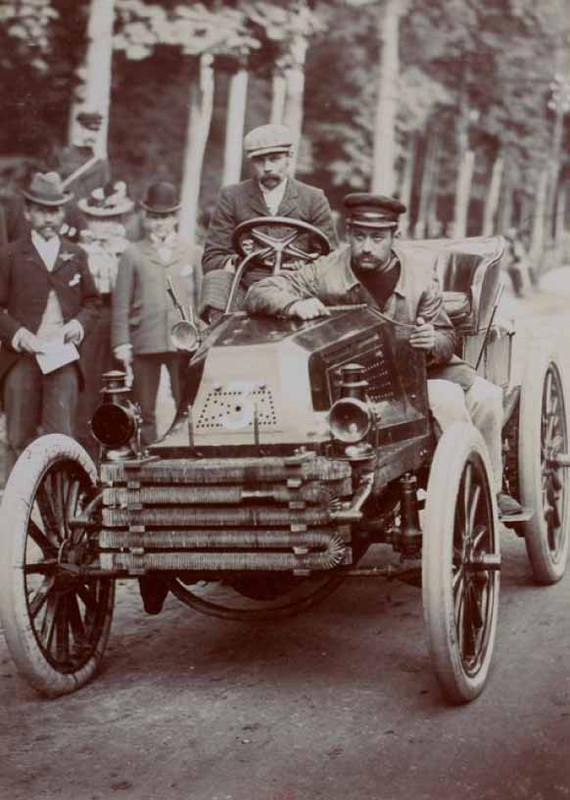
= = = =
Levegh's sister was married to Gustave Ström, one of the Ström sons of Ström & Fils, the famous "Tailleurs de l'Automobile", tailors to the Automobile Club de France. The shop was at 16 Rue de la Chaussée-d'Antin.
Maybe Madame Leys was a customer of Ström & Fils.
#43

Posted 22 January 2020 - 18:08
March 1900:
Léon Théry in (or on) his Decauville after winning the voiturette race (voiturette in 1900 = cars between 251 and 400 kg) called "Coupe des Voiturettes" from St. Germain to Rouen and back (217 km).
(photo Jules Beau collection)
= = = =
Last week of October 1904:
Gustave Caillois, Léon Théry and Barney Oldfield at the Empire City track, Yonkers, New York.
(photo Detroit Public Library)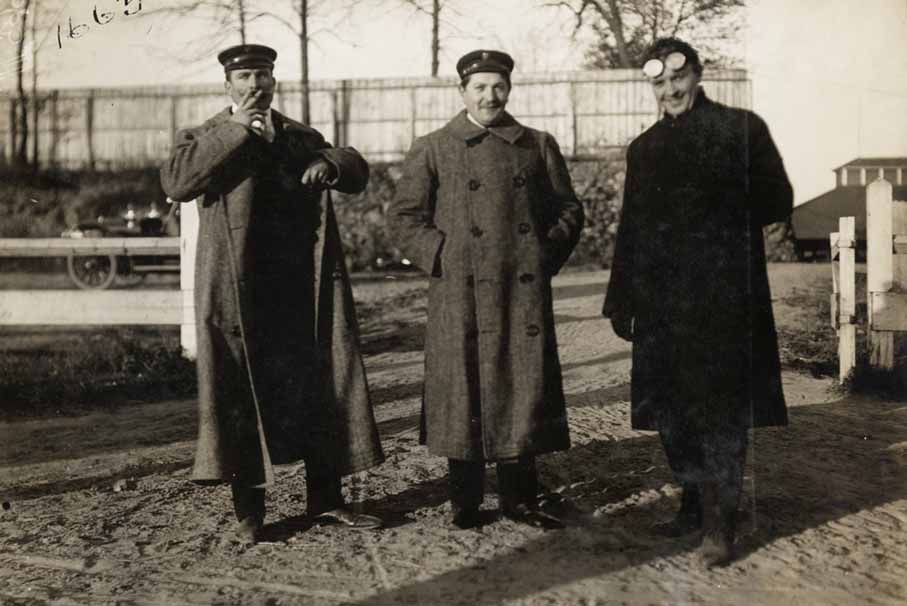
Théry and Caillois came to New York in the second week of October 1904.
On Saturday, 29 October 1904, on the Empire City track, Théry started at the wheel of his Bennett Cup winning Brasier in a 10-mile match (= 10 laps) against Paul Sartori in a Bennett Fiat (or F.I.A.T.). Sartori won a quarter of a mile ahead of Théry.
Later in the afternoon, Oldfield in the Peerless "Green Dragon" won against Sartori.
On 3 November, Théry and Caillois sailed back to France.
#44

Posted 22 January 2020 - 18:34
#45

Posted 22 January 2020 - 22:24
These are fascinating photos, Robert. Thank you.
Seconded!
#46

Posted 22 January 2020 - 23:27
Indeed. What a great thread this is - please keep going!
#47

Posted 23 January 2020 - 05:34
I'd give anything to have lived back then. You can have today.
#48

Posted 23 January 2020 - 06:04
On the other hand I doubt Charles Leclerc is going to die of TB before he is 30.
#49

Posted 23 January 2020 - 09:00
March 1900:
Léon Théry in (or on) his Decauville after winning the voiturette race (voiturette in 1900 = cars between 251 and 400 kg) called "Coupe des Voiturettes" from St. Germain to Rouen and back (217 km).
(photo Jules Beau collection)
I like the spare tube slung around the lamp! ![]()
Btw, that's a proper voiturette - see the inadequacy of calling an ERA, or a Formula 3000 car a "voiturette"?
#50

Posted 23 January 2020 - 09:10
I like the spare tube slung around the lamp!
Btw, that's a proper voiturette - see the inadequacy of calling an ERA, or a Formula 3000 car a "voiturette"?
but just to add a bit of confusion, Decauville's name for their road car of this type was "Voiturelle" ![]()











